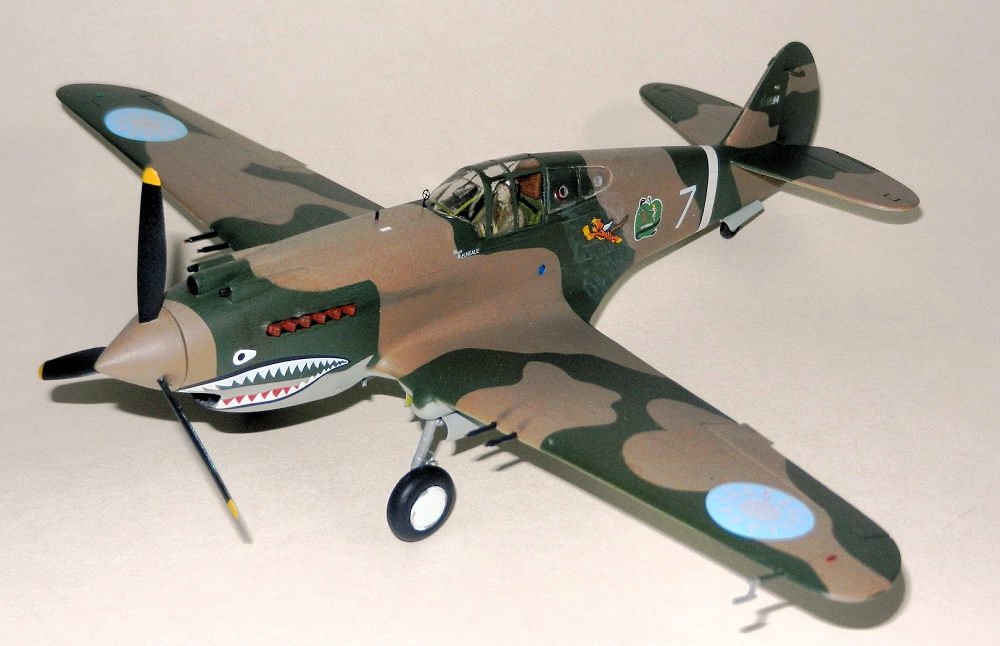
Revell (Monogram) 1/48 P-40B Warhawk
| KIT #: | 5209 |
| PRICE: | $ |
| DECALS: | Two options |
| REVIEWER: | Pablo Calcaterra |
| NOTES: | Sky Models 48047, Cutting Edge 48255 and Kits World 48058 |

| HISTORY |
Robert “Bob” Hawthorne Neale was born in Vancouver, Canada on May 3, 1914. He joined the US Navy in 1938 and won his wings in 1939 becoming a dive bomber pilot on USS Saratoga where he flew Helldivers and Dauntless. In June 1941 he resigned his commission and joined the AVG. Thus in July along with the first group of pilots and ground crew and posing as a rancher (everyone had a fake identity to avoid Japanese reactions as the US was still neutral) he left for SEA aboard the Jaegersfontein who was escorted by to USN warships and then by the Dutch “Java”. The ship arrived in Rangoon, Burma on August 15th 1941 and they immediately proceeded to Kyedaw airfield.
On December 20th the AVG took off for the first time to intercept a Japanese raid to Kunming in China. So far they had been bombing at will. This time the AVG was waiting for them and gave the unescorted bombers a bloody nose. During this epic battle where very accurately the AVG pilots claimed 4 bombers shot down Neale, a modest man, said that he did not know if he had even hit anything.
After the bloody battles of Burma and with the strength of the Panda Bears and the Hell Angels’ diminishing during the exchanges with the Japanese Claire Chennault decided to send 10 Adam and Eves to Mingaladon early January 1942. Leading this already tired planes was Bob Neale.
On
January 20th 6 AVG Tomahawks escorted 6 RAF Blenheims that bombed the
Japanese based located in Mae Sot in Thailand. Nates rose to challenge the
planes and in this combat Neale claimed a Japanese fighter shot down but it
does not appear in the official AVG list of victories. His next claim came a
few days l ater when RAF Hurricanes and the AVG intercepted another raid on Mingaladon. The following day January 23rd the RAF with Buffaloes and
Hurricanes and the AVG took on yet another Japanese raid. The AVG went after
the Sally bombers. Neale shot down two closing in the first case to100 yards
and to 50 yards in the second case (the bomber explosion flipped his plane
upside down and decided to return to his base). When leaving the combat he
shot at a Nate, was attacked by two more who hit his plane in the cockpit
with two low caliber bullet and one that shot off his microphone from his
helmet (“Too damn close” he recorded in his diary).
ater when RAF Hurricanes and the AVG intercepted another raid on Mingaladon. The following day January 23rd the RAF with Buffaloes and
Hurricanes and the AVG took on yet another Japanese raid. The AVG went after
the Sally bombers. Neale shot down two closing in the first case to100 yards
and to 50 yards in the second case (the bomber explosion flipped his plane
upside down and decided to return to his base). When leaving the combat he
shot at a Nate, was attacked by two more who hit his plane in the cockpit
with two low caliber bullet and one that shot off his microphone from his
helmet (“Too damn close” he recorded in his diary).
January 26th saw Neale again in action against the Japanese. Though 2 Nates were claimed by the Allies (two by Neale) the attackers only lost one.
Neale became an ace on February 6th when he claimed a Nate during an engagement between two large gaggles of Japanese fighters and the Allies. Though only one Japanese plane shows in their records as lost the AVG+RAF claims totalize 7 kills.
The following day while testing repaired Tomahawk that had received battle damaged the Adam and Eve’s Squadron Leader Sandy Sandell died. Neale was one of the few that respected Sandell and was named his replacement though he did not cherish his new position. He tried to pass it on to Greg Boyington who declined and instead Neale name him his vice squadron leader. Neale was very stressed because of his new responsibility and did it because he had to.
By then the Adam and Eves had 16 planes and 22 pilots many of which did not want to fight anymore and the Japanese had switched their annihilation campaign to a different part of the front.
On February 21st RAF Blenheims, Hurricanes and the AVG were sent to bomb and strafe a Japanese column which was badly hit…thought it turned out that it was the Indian 17th Division retreating from the Japanese. Chaos was now rampant in Rangoon.
From there several successful ground attacks were carried out against Japanese columns and airfields.
The final campaign against Mingaladon started on February 25th and to match the speed of the Allied fighters the Japanese included for the first time the Ki-44s. Scramble happened at 10.30 and the 1st Squadron participated with 6 planes but only 3 (led by Neale) made contact with 20 enemy fighters. Though Neale claimed 2 Nates and two more by his wingmen no Japanese plane was lost…and no Tomahawk either though the Japanese claimed 12 kills! On the same day in the afternoon 12 bombers escorted by 30 fighters attacked the Allied airfield again. Neale led his planes that joined the Hurricanes in the interception. 25 Japanese planes were claimed (2 by Neale) and one AVG plane and one Hurricane were lost in the process. Actual Japanese losses were…2!
On
the 26th a false alarm made the Adam and Eves scramble but it proved to be a
false alarm. Now that they were in the air Neale decided to take his 7
Tomahawks and attack an enemy airfield at Mudon. Two
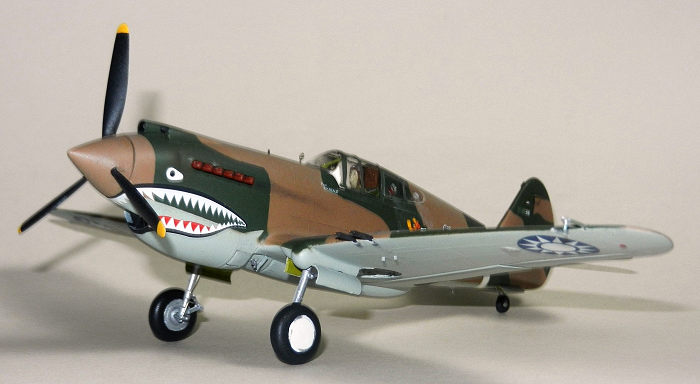 enemy planes on the
ground were attacked but Nates returning from their own raid and more Nates
taking off tangled with the P-40s. One of them latched to Neale’s plane and
because they were flying so low he was unable to dive for safety. Thus he
sped at low height making himself little in front of his seat hoping that
his plane would bring him back. Upon returning he said that the Japanese
were not able to hit the doors or a barn…but his plane had collected 17
bullets fired by the Japanese pilot in the tail and fuselage! Could not hit
a barn…but had no problem in hitting a P-40!
enemy planes on the
ground were attacked but Nates returning from their own raid and more Nates
taking off tangled with the P-40s. One of them latched to Neale’s plane and
because they were flying so low he was unable to dive for safety. Thus he
sped at low height making himself little in front of his seat hoping that
his plane would bring him back. Upon returning he said that the Japanese
were not able to hit the doors or a barn…but his plane had collected 17
bullets fired by the Japanese pilot in the tail and fuselage! Could not hit
a barn…but had no problem in hitting a P-40!
The Japanese returned to bomb them in the afternoon. The bombers were very well protected and only one was shot down and another one damaged (confirmed by Japanese records) while the fighters claimed 17 for the entire day with the Japanese showing only one Nate lost in combat and 2 on the ground during the attack in the morning. In all the RAF and the AVG claimed 43 enemy planes in these 2 days of fighting with the Japanese curiously claiming the same number…clearly both were significantly over claiming.
During dinner on the 26th RAF Captain Broughall told Neale that the radar was being disassembled and that the Observation Corps were also leaving. Thus there was going to be no warning and at 2.30 am the following morning Neale called his pilots and they left Mingaladon for good taking as many planes they could back to China (to be repaired) or RAF dispersal airfields further North. On the 28th after waiting in vain for the return of Ed Leibolt (shot down a couple of days before) Neale and Snuffy Smith left Rangoon. By the end of March the campaign had ended in victory for the Japanese who had a 5 to 1 advantage in the air.
On March 21st Chennault ordered a reprisal attack from the AVG base at Kunming. The best 10 pilots were picked. They were to split into two in order to attack 2 airfields in Thailand: 6 Adam and Eves led by Neale to Chiang Mai and 4 Panda bears (led by Jack Newkirk their leader) to the other one at Lamphum. During the attack to a cart travelling on a road Nwekirk was either shot down or crashed by mistake. More successful were the Adam and Eves that attacked Chiang Mai by surprise. Though they claimed 15 Japanese planes destroyed (Neale counting around 40 on the ground) thru heavy flak the actual record is 3 destroyed and 10 damaged. One of the P-40s was hit by the AAA fire and Black McGarry had to do a force landing being captured by the Thais and becoming a POW.
When the Pilot’s Revolt happened in April Neale was one the leaders that managed to diminish the impact and reduce the number of AVG members that quit.
On May 2nd Neale led 8 Tomahawks to escort some Chinese SB bombers that were to hit the Japanese in Northern Burma. The raid proved to be a milk run.
The following day and during a recco mission in strength (6 planes) Neale shot down a Japanese Observation plane thus becoming the first triple ace of the AVG.
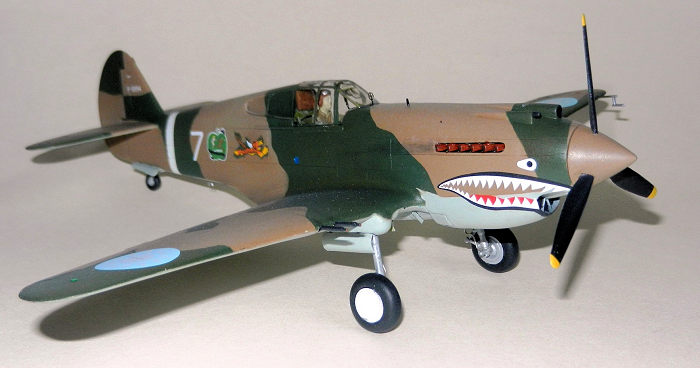 Neale
participated in the attacks on the Salaween river flying escort to the
recently arrived Kittyhawks that now were flying with the Adam and Eves.
Neale
participated in the attacks on the Salaween river flying escort to the
recently arrived Kittyhawks that now were flying with the Adam and Eves.
June 12th saw a large battle over Guilin, the new base of the AVG in China. 5 bombers escorted by 8 Nates and 5 Toryu (in their combat debut) approached the base. During the running combat in which the new twin fighters probed to be a difficult foe (including Neale having difficulty shaking off a Toryu from his tail) the AVG claimed 9 planes with actual Japanese losses being 3 bombers, 1 Nate and 2 Toryu (including their leader)…quite a close match for a change! One of the Japanese pilots was captured and during the interrogation he commented that the Toryu was heavily armed. The AVG pilots had attacked them head on thinking they were bombers…Neale exclaimed “No more head on runs for me!”
With the AVG disbanded after July 4th Neale was one of the few pilots that continued to fly with the 23rd Fighter Group for 2 weeks as Commander of the 23rd FG. He was one of the last AVG members to leave China arriving back in the USA in August 1942. He declined an offer to become a Major in the USAAF and then flew with American Overseas Airlines until he retired in 1950. With 15.5 kills confirmed by the Chinese Bob Neale was the top scoring ace of the AVG.
| THE KIT |
For a comprehensive review check Scott’s 2016 preview here.
| CONSTRUCTION |
I built this kit in the 90s while still living in Argentina. Without Internet at the time and little information I followed Revell’s instructions to the dot including markings and paint scheme. Which of course we know those are really wrong! But at the time I was happy that my Flying Tiger was as close as possible to the instructions.
Come Canada and Clement’s book. I decided to build a P-40 from each one of the 3 AVG squadrons. And the 1st Squadron would be based on the oldest kit (Revell), 2nd Squadron based on the next kit released (Hobbycraft) and the 3rd Squadron using the Trumpeter kit. With more sources now available I fully understood the shortcomings of each kit (including my mistakes praising the HC kit in my MM Pearl Harbour P-40 review…)
Instead of purchasing another Revell kit I took the one brought from Argentina and carefully pulled it apart with not a lot of fuss (Back in 1990 I did not know that I had to remove the paint from the matching surfaces before gluing…)
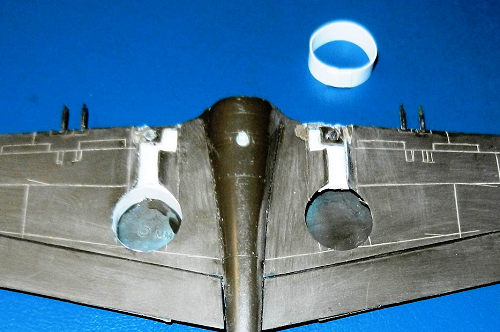 When the plane was broken down (except for the
fuselage halves…good job there!) I sanded away all the paint and rivets. And
then using scale plans and Dyno tape rescribed all the panel lines. I took out
the cockpit floor and seat to paint them in the correct colours but left the
pilot as I had painted him in the 90s. I made a copy of the HC instrument panel
(with plaster of Paris and two part epoxy) including the machine gun butts made
with rectangles of plastic.
When the plane was broken down (except for the
fuselage halves…good job there!) I sanded away all the paint and rivets. And
then using scale plans and Dyno tape rescribed all the panel lines. I took out
the cockpit floor and seat to paint them in the correct colours but left the
pilot as I had painted him in the 90s. I made a copy of the HC instrument panel
(with plaster of Paris and two part epoxy) including the machine gun butts made
with rectangles of plastic.
With this accomplished I turned to the wings where I added walls to the wheel wells using rings of Evergreen cut to shape and painted them in Interior Green. Some putty was required to smooth the union of wings and fuselage. And then moved on to the most critical fix of the kit…
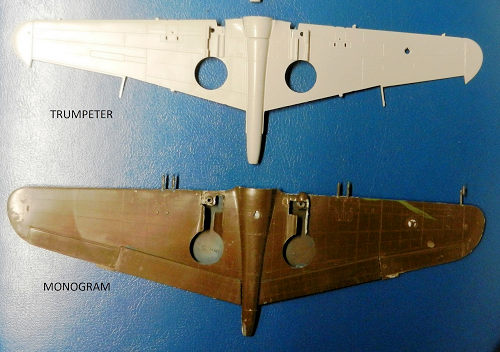 Though many people have praised the “nun-hat” of the
Revell kit I find the area immediately behind the cowling flaps suspicious
(extremely wide) and decided to replace it using a copy of the Trumpeter kit. I
made 2 molds (one for the HC kit and the other one for Revell’s) and filled them
using 2 part epoxy. Breaking carefully the molds I ended up with 2 decent
copies.
Though many people have praised the “nun-hat” of the
Revell kit I find the area immediately behind the cowling flaps suspicious
(extremely wide) and decided to replace it using a copy of the Trumpeter kit. I
made 2 molds (one for the HC kit and the other one for Revell’s) and filled them
using 2 part epoxy. Breaking carefully the molds I ended up with 2 decent
copies.
Then surgery had to take place on the ventral part of
the bottom half of the wings. I removed this part alon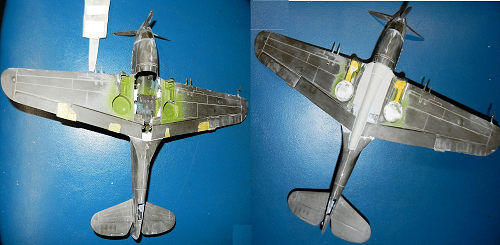 g the panel lines and
carefully, after lots of dry fitting and testing, glued the new ventral copy
using some plastic strips as support. Then putty fixed the gaps here and there
and some more scribing completed the new underbelly of my Revell kit.
g the panel lines and
carefully, after lots of dry fitting and testing, glued the new ventral copy
using some plastic strips as support. Then putty fixed the gaps here and there
and some more scribing completed the new underbelly of my Revell kit.
With tissue paper I created the fabric cover of the wheel wells. I drilled 2 shallow holes on the side of the fuselage below the cockpit (formation lights) and with a smaller drill bit the two points to hoist the fuselage close to the tail.
Now I was ready for the real fun…painting the plane!
| COLORS & MARKINGS |
I used scale plans from Tullis’ book to make a template of the camo pattern.
A coat of light grey was used to check for any imperfection. I painted the area before the tail in white and then masked the Squadron ID band. Also in white were the wheel hubs to identify the 1st Squadron machines.
There has been a lot of debate (just check the Web!) about the actual colour of these planes. They were, clearly, a close match (or as close as Curtiss wanted to stretch their efforts) to the RAF colours.
In this case, “7” was one of the longest serving original planes (was handed out to the 23rd FG!) and the paint was very much worn out which made it change to a different hue.
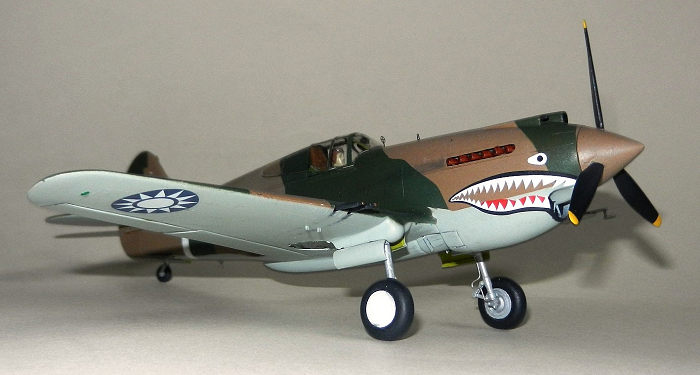 But first things first! The undersides were painted
with ModelMaster Acryl 4693 which is an excellent match of the original colour.
Then this was masked and I painted the light brown (ModelMaster Acryl 4709) to
which, once dried, I sprayed a very light and much diluted coat of Sand (ModelMaster
Acryl 4711) as the pilots described a faded out cammo especially on the wings,
tail and fuselage spine (not so much on the fuselage halves)
But first things first! The undersides were painted
with ModelMaster Acryl 4693 which is an excellent match of the original colour.
Then this was masked and I painted the light brown (ModelMaster Acryl 4709) to
which, once dried, I sprayed a very light and much diluted coat of Sand (ModelMaster
Acryl 4711) as the pilots described a faded out cammo especially on the wings,
tail and fuselage spine (not so much on the fuselage halves)
Then it was time to mask the brown using the template mentioned above cut in Tamiya tape. The green (ModelMaster Acryl 4726) was applied followed by a very diluted and light coat of a darker shade of green (ModelMaster Acryl 4729) as the green turned a darker/bluish tone when exposed to the sun.
Propeller is black with yellow tips. I used a thin black pencil to highlight the moveable surfaces and my typical sanded black pastels to give them a little bit of dirt. Same method was used for the machine guns and exhaust stains.
All formation lights were first given a drop of light grey, followed by silver and then a drop of Future with a touch of blue (fuselage) or clear red or blue for the wings. White was used for the ones on the tail.
The caps behind the pilot were painted in red and aluminum. Another tricky part was to simulate the dirty pattern created by the overflowing fuel below these caps. For this I used water with a drop of white and then put a tiny amount of this mixture on the fuselage blowing it downwards. It was repeated several times until it looked dirty enough with a help of a damped Q tip.
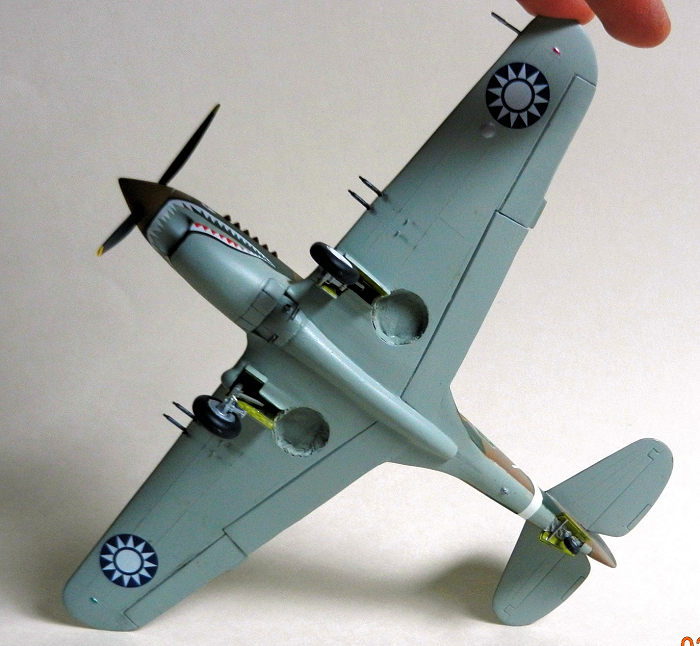 Exhausts were painted using Rust colour and the
openings black.
Exhausts were painted using Rust colour and the
openings black.
As the Disney Flying Tiger decal was applied over seemingly a fresh coat of paint or very clean surface plus then doped over it I made a template of the tiger and drybrush the profile using dark green.
The kit was given a coat of Future and was ready for the decals.
In terms of decals I found the Sky Models ones to be very good and accurate and most of the ones used on my kit came from it. They reacted perfectly to Set and Sol solutions. The light blue version was used for the top of the wings (sun faded) and dark blue ones for the bottom of the wings. These roundels came for the Hobbycraft kit as the light blue is the lightest one (thus most sun faded)
The serial number on the left side of the tail seems to be worn out in some pictures and thus I lightly sprayed the front half of the decal using the darker shade of green used in my kit. And as I did not have the Prestone one located on the nose I just cut a white rectangle minus the letters of course.
| FINAL CONSTRUCTION |
Lots of attention was given to the final details. These include photoetched gunsight, the two little pipes under the fuselage, the oil vents by the nun hat, two flaps opening on the first section of the nun hat (made with Evergreen), the horn on the tail (for the rudder), drilling holes on the left side of the fuselage Plexiglas panels (access to the fuel loading caps), pitot and a little tab on the front of the vertical surface of the tail.
The on-the-field designed reflector gunsight was made up with clear plastic layers following the pictures found in Larry Pistole’s book.
A drop of brown was applied to the 4 wing machine guns to simulate dope.
Finally the canopy and windshield were glued in place and with this my tribute to Bob Neale was finished.
| CONCLUSIONS |
A great challenge, lots of fun and feeling of accomplishment. The plane looks the part starting with the basically sound shape of the old Revell/Monogram kit.
| REFERENCES |
Pictorical History of the Flying Tigers by Larry Pistole
Tigers over China by T. Tullis
AVG Colours and Markings by Terrill Clements (Osprey)
Flying Tigers by Daniel Ford
18 May 2018
Copyright ModelingMadness.com
If you would like your product reviewed fairly and fairly quickly, please contact the editor or see other details in the Note to Contributors.
Back to the Main Page Back to the Review Index Page Back to the Previews Index Page